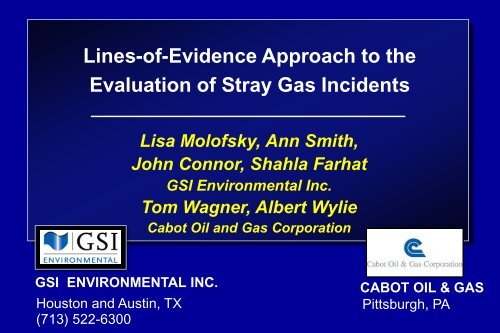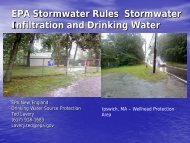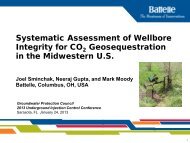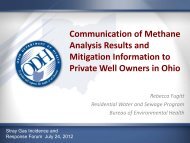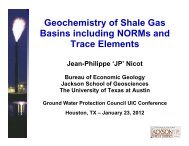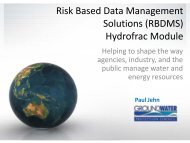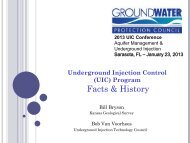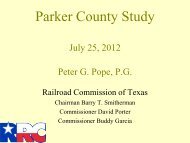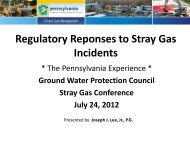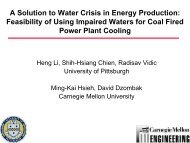Lisa Molofsky
Lisa Molofsky
Lisa Molofsky
You also want an ePaper? Increase the reach of your titles
YUMPU automatically turns print PDFs into web optimized ePapers that Google loves.
Lines-of-Evidence Approach to the<br />
Evaluation of Stray Gas Incidents<br />
<strong>Lisa</strong> <strong>Molofsky</strong>, Ann Smith,<br />
John Connor, Shahla Farhat<br />
GSI Environmental Inc.<br />
Tom Wagner, Albert Wylie<br />
Cabot Oil and Gas Corporation<br />
GSI ENVIRONMENTAL INC.<br />
Houston and Austin, TX<br />
(713) 522-6300<br />
CABOT OIL & GAS<br />
Pittsburgh, PA
Methane in Groundwater:<br />
Anthropogenic or Natural?<br />
GAS WELL MIGRATION<br />
NATURAL GAS SEEP<br />
House Explosion, Western PA<br />
KEY<br />
POINT:<br />
Eternal Flame Falls, NY<br />
Multiple sources of methane in shallow<br />
groundwater. Source identification challenging.
Practical Guidelines for Evaluation of<br />
Methane Impacts on Groundwater<br />
• Case Study: Marcellus, NE PA<br />
• Problem: Asserted that<br />
Marcellus shale gas<br />
extraction was causing stray<br />
gas impacts on water wells<br />
• Lessons Learned: Lines of<br />
Evidence for Stray Gas<br />
Studies<br />
Susquehanna<br />
County<br />
PENNSYLVANIA
Methane Impacts on GW in Northeastern Pennsylvania:<br />
Regional Survey of “Pre-Drill” Methane in Water Wells<br />
“Pre-Drill” Methane in >1700 Water Wells, 2008 - 2011<br />
FINDINGS<br />
■ 78% of water wells contain methane<br />
■ Higher concentrations in valleys vs. uplands
Mechanism for Methane Accumulation in Valleys?<br />
Methane from Shallow Subsurface<br />
Valley Faults and Fractures<br />
http://science.kennesaw.edu/
Underlying Geology of Northeastern PA:<br />
Non-Producing Gas-Bearing Units<br />
Key Strata<br />
Geologic Cross Section: Susquehanna County<br />
■ Glacial Till: Contains<br />
Microbial Gas<br />
■ Catskill &<br />
Lockhaven<br />
Formations:<br />
Thermogenic gascharged<br />
sandstone<br />
deposits (with<br />
extensive fracture<br />
networks)<br />
■ Marcellus shale: Gas<br />
at ~6000 ft below<br />
surface.
Underlying Geology of Northeastern PA<br />
Key Point<br />
Organic<br />
seams in<br />
Catskill<br />
formation<br />
are potential<br />
source of<br />
thermogenic<br />
gas
Fault and Fracture Networks<br />
Seismic Line: Susquehanna County, NE PA<br />
Large-Scale<br />
Faults<br />
Tully<br />
Limestone<br />
Question:<br />
Barriers to gas migration from deeper<br />
units or structural connections?
Historic Locations of Gas Shows: 200 years<br />
Key Point<br />
Shrewsbury Gas Field, 1969<br />
Lovelton Gas<br />
Field, 1965<br />
Salt Springs, pre-1800<br />
Shallow gas<br />
shows<br />
observed<br />
in water and<br />
gas wells<br />
for over<br />
200 years<br />
Harveys Lake Gas Field, 1956
Salt Springs State Park, PA:<br />
Historic Bubbling Spring<br />
Susquehanna<br />
County, PA<br />
Inscription on rock<br />
wall behind spring:<br />
“JMK 1862”
Water Well Construction and Aquifer<br />
Dynamics in NE Pennsylvania<br />
WATER WELLS:<br />
• Most wells penetrate the<br />
Catskill Sandstone<br />
• Open hole completions,<br />
draw water from fractures<br />
GAS WELLS:<br />
• All pass through Catskill<br />
and Lockhaven<br />
• Surface casing<br />
• Open annular spaces<br />
• Casing integrity<br />
Source: PA DCNR, 2012
Isotope Analyses: Source Gases<br />
Identified by Pennsylvania DEP and Cabot<br />
Upper and Middle<br />
Devonian Gases<br />
Above Marcellus<br />
Marcellus<br />
Shale Gas<br />
Source Gases<br />
Marcellus<br />
Production Gas<br />
(PA DEP & Cabot)<br />
CO 2<br />
Reduction<br />
Microbial Gas<br />
Thermogenic<br />
Gas<br />
Fermentation<br />
Upper / Middle<br />
Devonian Gas<br />
Above Marcellus<br />
(PA DEP)<br />
Dissolved Gas<br />
Identified as<br />
Upper/Middle<br />
Devonian (PA DEP)<br />
KEY<br />
POINT:<br />
Local Marcellus shale gas may be distinguished from<br />
shallower overlying Upper and Middle Devonian gases.
Isotope Analyses: Water Well Gases<br />
Sampled by PA DEP, Cabot Oil, and Duke Univ.<br />
Upper and Middle<br />
Devonian Gases<br />
Above Marcellus<br />
Marcellus<br />
Shale Gas<br />
Water Samples<br />
Water Wells:<br />
Dissolved Gas<br />
(PA DEP & Cabot)<br />
CO 2<br />
Reduction<br />
Microbial Gas<br />
Thermogenic<br />
Gas<br />
Fermentation<br />
Osborn et al. Study:<br />
Dissolved Gas<br />
In Water Wells<br />
Spring:<br />
Salt Springs<br />
State Park<br />
(Cabot)<br />
KEY<br />
POINT:<br />
Dissolved gases from local water wells are most consistent<br />
with microbial or shallow thermogenic sources.
Lessons Learned:<br />
Lines of Evidence for Stray Gas Investigations<br />
Geology/<br />
Hydrogeology<br />
Presence of gas-bearing strata, fault and<br />
fracture systems, aquifer dynamics<br />
History<br />
Regional<br />
Patterns<br />
Well<br />
Construction<br />
Prior oil and gas activity, stray gas<br />
incidents and evidence of naturallyoccurring<br />
gas seeps.<br />
Regional patterns of methane occurrence<br />
and composition.<br />
Construction and completion details for<br />
affected water wells and nearby gas wells.<br />
Geochemical<br />
Fingerprinting<br />
Analyses of composition and isotopic<br />
signatures of gas sources.
OBJECTIVE:<br />
Effective approach for<br />
evaluation of potential<br />
impacts of shale gas<br />
development on GW<br />
resources.<br />
Credit: Bennett V/Flickr


